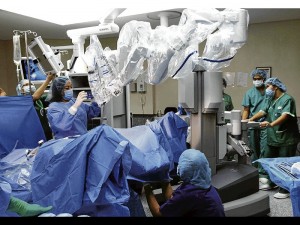Robotic surgery a sci-fi dream now a reality

You’d think robotics in surgery was just a scene in a science fiction movie. But no, the technology is now a reality. Robotic surgery is a breakthrough surgical technology which raises the bar of surgical management in the Philippines with a new category of minimally invasive surgery in the country.
What is robotic surgery?
Yes, it’s exactly how it sounds. It is the use of robots in performing surgeries.
The Da Vinci Surgical System is a sophisticated robotic setup capable of expanding the operator’s surgical skills, allowing the surgeon to operate with unmatched accuracy, vision and control. Furthermore, the surgeon can offer a minimally invasive option which is far more precise than laparoscopic surgery, in place of a major traditional surgery.
The Da Vinci robotic system is made up of 3 main components: a surgeon’s console; a patient-side robotic cart with 4 arms manipulated by the surgeon (one to control the camera and three to manipulate instruments); and a high-definition 3D visual system that allows the surgeon to see the operative field in stereoscopic vision.
In performing robotic surgery, the surgeon is relaxed sitting in the console from where he can see a magnified, high-resolution three-dimensional image of the part of the body to be operated on. Instead of the traditional 50-100 mm large incisions with conventional surgery, with robotic surgery, miniaturized, wristed instruments are introduced through small incisions ranging from 5 to 12 mm and allows the surgeon to see the surgical site in true stereoscopic vision, at 10-12 times more magnified than the naked eye can see. This allows the surgeon a better view of blood vessels and nerves that need to be avoided or dissected out.
Furthermore, the robotic and computer technologies combine to sense the surgeon’s hand movements and scales it to seamlessly and electronically translate the surgeon’s hand movements into precise micro-movements. It also filters out any tremors in the surgeon’s hands so they will not manifest in the robotic instruments. Contrary to your fears that the robot might run amuck, the system cannot move by itself nor can it decide for itself but requires that every move be performed through the direct manipulation by the surgeon.
The system is named after Leonardo da Vinci who invented the first robot. He was the artist who created masterpieces drawn with unparalleled anatomical accuracy and three-dimensional details. The Da Vinci Surgical System similarly provides physicians with such enhanced detail and precision that the system can simulate the process of a traditional open surgery while allowing operation through tiny incisions.
Robotic surgery offers several potential benefits over traditional approaches, including:
• Small incisions and therefore minimal to invisible scarring;
• Significantly less pain because the wounds are so small a band-aid can cover them;
• Minimal blood loss and need for transfusion;
• Fewer complications, such as post-operative adhesions because there is less manipulation and injury to tissues; or inadvertent damage to normal vessels and nerves due to higher magnification of structures;
• Shorter hospital stay which is reduced from 24 to 48 hours for a surgery that used to have a 4-5 day stay;
• Quicker recovery and return to normal activities – return to work within a week with a surgery that used to take 4-8 weeks downtime;
• Better outcomes and patient satisfaction;
More comfortable and less muscle fatigue for the surgeon who is seated throughout the surgery performing the surgery from the console as opposed to standing for 5 hours or more in performing a difficult cancer surgery.
Among its most popular applications are surgeries in the following fields:
• Cardiothoracic – coronary artery bypass, coronary stenting, mitral valve repairs and replacement, esophagectomy, lung resection, tumor resections;
• General surgery – all general surgical procedures including cancer surgery and bariatric surgery;
• Gynecology – removal of ovarian cysts, endometriosis, myomectomy, uterine prolapsed, hysterectomy, pelvic cancer surgery; and
• Urology – removal of the prostate gland for cancer, repair of obstructed kidneys, repair bladder abnormalities and remove diseased kidneys, kidney transplants.
In the Philippines, where surgeons, urologists and gynecologists are just beginning to embrace laparoscopic surgery, it’s awesome to think that the sci-fi dream of robotic surgery is now a reality and will once more make us at par with surgical treatments that once upon a time, were only available in first world countries.
